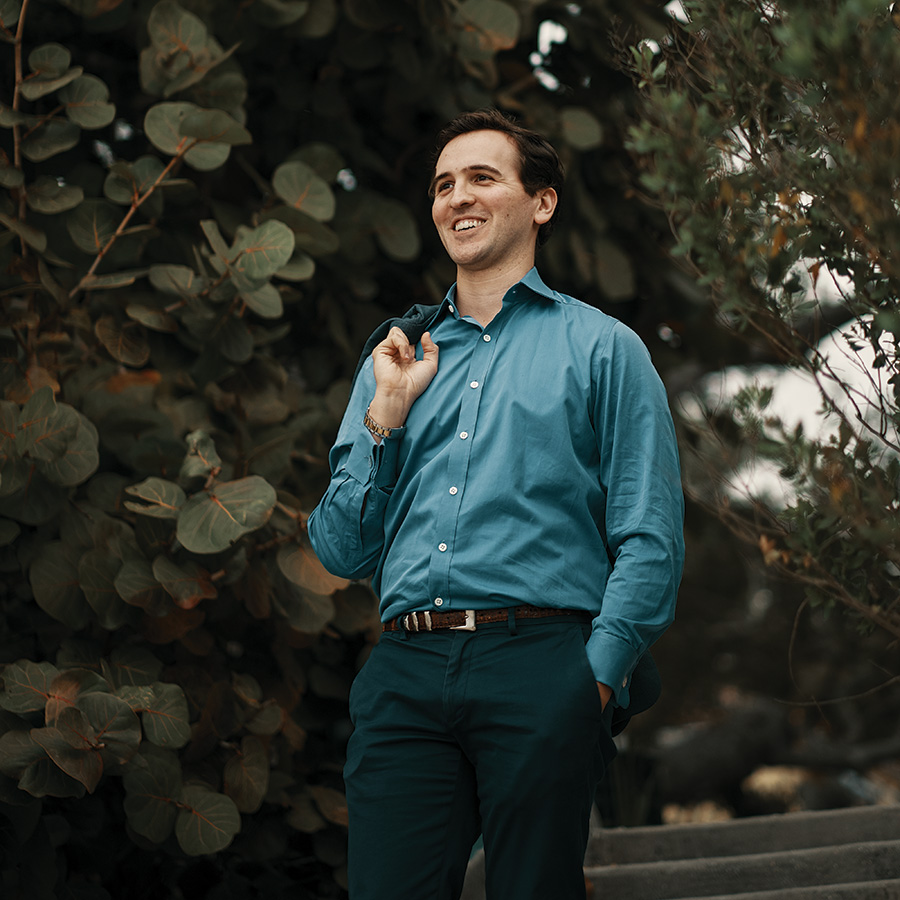In its first 15 years, a dream became reality for the Hermitage Artist Retreat as a neglected bit of beachfront grew into an exclusive destination for acclaimed artists—the kind who show at Art Basel and win Pulitzer Prizes—all coming to Sarasota to create new work and engage the community. So when the founding Executive Director Bruce Rodgers announced he would be stepping down this past December, the Hermitage kicked off a national search for the right fit for some pretty big shoes. The nonprofit found its answer in Andy Sandberg, a prolific director and playwright on both the New York City and West End theater scenes, and the youngest producer in history to win a Tony Award. Naming Sandberg Artistic Director and CEO, he took up his post as of January 2020. SRQ caught Sandberg after his first board meeting to talk new chapters, big plans and leaving Broadway for the beachfront.
SRQ: After New York City, was Sarasota a hard sell for a young artist? Andy Sandberg: I did not have to be sold on Sarasota; it has an amazing arts community. I directed a workshop at the Asolo about 10 years ago and I’ve been down here various times and I knew what a wonderful community it was for supporting the arts. And the mission of the Hermitage was exciting. Most of my career has been based in the development of new work and new artists, so having the opportunity to help other artists develop their projects and their craft, to give them a life-changing experience, was really exciting to me.
What advantages are you seeing that Sarasota has over New York City? Everyone in this community is engaging in the arts in a way that is quite rare. Even in New York, if I go into a restaurant or coffee shop, not everyone is going to be able to articulate their experiences in the theater or the museum or the opera. Whereas, that is such an institution and part of the culture in Sarasota and part of what gravitates people here above anywhere else. People move to Sarasota and stay in Sarasota because they believe in and want to support the arts.
At this point in your career, why was this the direction to take? I love having an artistic home that I can look at as building something larger than any one project. And that’s particularly exciting about the Hermitage. But I’m still going to keep a foot in the freelance world. One thing I said to the board and the staff is that the Hermitage is my number one priority and I am very eager to take it on, but I am also a working artist who looks forward to opportunities to be in the rehearsal room when I can.
That sounds like quite the juggling act. I always have to now look through the lens of how is this also going to serve the Hermitage in addition to me as an artist. But I’m excited by that. It means that not necessarily every single project that crosses my desk is something that I’m going to say yes to. I have to be very conscious of how massive and important a commitment this is. I take it very seriously. But I also think that having my fingers and toes in other aspects of the industry is only good for the Hermitage brand and vice versa.
In what way? It gives me a chance to be an ambassador. I want to be spreading the mission of the Hermitage nationally and internationally. I want our name to be known throughout New York, London, Chicago, LA and every other major arts community that there is.
Bruce Rodgers led the Hermitage as executive director. You now lead as artistic director and chief executive officer. Why the change? Part of it was wanting to make it clear that this is a new chapter of the organization and that it was not simply stepping into my predecessor’s shoes. I so admire what he has built with the Hermitage, but I’ve made it clear I wasn’t interested in just coming in and doing things exactly the same way and that’s not what he would’ve wanted either.
Did he give you any advice? Bruce gave me a ton of advice and was incredibly supportive throughout the transition. He made himself available for questions, but also gave free range, saying, “Listen, this is your chapter to write. I’m available as you need me.” I applaud him for everything he’s done with the organization and the way he has allowed this transition to flourish and take shape.

Why do you think the board chose you for this next step? I have always straddled the creative and the business in what I do. I have always been about developing and supporting new works and thinking outside of the box, finding ways to bring projects and artists to audiences. So they know that I value development as much as I value production. My favorite place to be is in that development and rehearsal process. Production is great, but it’s even more fun putting it all together and being there from the nascent stages.
What about that business side? I also have an entrepreneurial spirit that I can bring toward a nonprofit arts culture. I so appreciate and admire the organization and how it has been running, but I am looking at it through a fresh lens. Bringing someone in from the outside gives all of us a chance to look at this and raise questions that might not have been raised. I don’t like to use the term disruptor, but I do like to raise every question and open big cans of worms when it helps the conversation. The two phrases that I don’t respond well to are, “the way things are done” or “the way things have been done.” I’m grateful that the board and the staff feel similarly.
What are you looking forward to most in this first year? Mostly, I’m really excited to make sure that people understand that this is a new chapter for the Hermitage, that is going toward writing the whole book. We are here to grow and flourish.
Long term? I want the Hermitage to be recognized as one of the top arts organizations in Sarasota. I am thrilled to be part of a community that has thousands of nonprofit arts organizations. I don’t just want to be one of the thousands. I want us to be perceived as one of the top players in the field and I want to make sure that everyone in town and around the world knows who we are, why we’re important and why we’re vital to the artistic landscape. There’s something very special about this community and this campus that allows people to create great art and then take a little piece of Sarasota with them when they go on to Lincoln Center, or the MoMA, or any other major gallery or concert hall around the world. On the national and international landscape, we want artists to be recognizing the importance and significance of the Hermitage. When you hear someone has won a Pulitzer, your eyes open up. There’s no reason we shouldn’t be striving for that.
Last question. The Greenfield Prize isn’t going anywhere, right?
No, the Greenfield Prize is one of the cornerstones of what we do, we’re incredibly proud of it. SRQ
About the Hermitage Artist Retreat:
Now on the National Register of Historic Places, the Hermitage was built in 1907 and was reconceived as The Hermitage Artist Retreat in 1999. Artists and writers live and work here for six-week residencies curated by national leaders in art and literature. We preserve Old Florida beach houses and the ancient native beachfront environment as a place to birth new art, new thought, and the world’s next great masterpieces.
Hermitage Fellows include nine Pulitzer winners; a host of MacArthur “Geniuses;” Grammy, Tony, and Emmy winners. Work created at the Hermitage is shown at New York’s Metropolitan Opera, the Vienna Opera, Lincoln Center, Carnegie Hall, Disney Hall, Mass MoCA, MoMA and the MET Museum.
With a mission to inspire the artists of our time, the Hermitage Artist Retreat invites the public to come see and hear cutting edge art, literature, drama and music in Sarasota area venues, and on the Hermitage beach at sunset in a series of free Friday programs.









